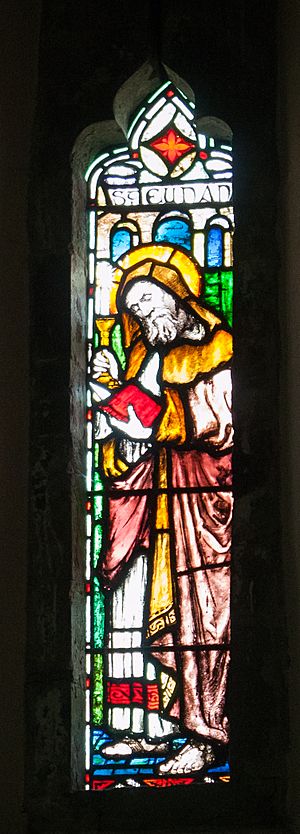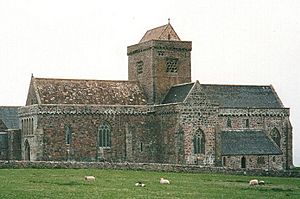Adomnán facts for kids
Quick facts for kids SaintAdomnán of Iona |
|
|---|---|

St. Eunan, Raphoe Cathedral
|
|
| Born | c. 624 County Donegal, Ireland |
| Died | 704 (aged c. 80) Iona, Scotland |
| Venerated in | Catholic Church Eastern Orthodox Church Scottish Episcopal Church |
| Canonized | Pre-Congregation |
| Feast | 23 September |
| Patronage | Roman Catholic Diocese of Raphoe |
Adomnán or Adamnán of Iona (born around 624 – died 704), also known as Eunan, was an important abbot of Iona Abbey from 679 to 704. He was also a writer, a statesman, and a saint. He wrote a famous book about Saint Columba, called the Vita Columbae. This book is very important because it tells us a lot about early medieval Scotland and the life of monks on Iona.
Adomnán also created a special set of laws called the Law of Adomnán, or "Law of Innocents" (Lex Innocentium). This law was designed to protect people who couldn't fight in wars. He also wrote a book called De Locis Sanctis ('On Holy Places'), which described important Christian pilgrimage sites. He learned about these places from a Frankish bishop named Arculf, who had traveled to many of them.
Contents
Adomnán's Early Life
Adomnán was born around 624 in Ireland, probably near a town called Raphoe. He was related to Saint Columba, who founded Iona Abbey. Adomnán came from a powerful family in northern Ireland called the Northern Uí Néill. His parents were Rónán mac Tinne and Ronat.
It is believed that Adomnán started his life as a monk at a monastery connected to Columba, possibly Durrow. He likely joined the group of monasteries led by Iona Abbey around the year 640. Adomnán became very learned, which was rare in Northern Europe during the Early Middle Ages.
Becoming Abbot of Iona
In 679, Adomnán became the ninth abbot of Iona, following in the footsteps of Columba. He was good friends with King Aldfrith of Northumbria, an English king. In 686, Adomnán traveled to the Kingdom of Northumbria to help free sixty Gaels who had been captured in a raid.
Adomnán made several more trips to England during his time as abbot. During these visits, he learned about the Roman way of calculating the date of Easter. This was different from the way Iona and many Irish monasteries celebrated Easter. Adomnán decided to adopt the Roman dating and tried to convince others in Ireland to do the same.
The Law of Adomnán
One of Adomnán's most famous achievements was creating the Cáin Adomnáin, also known as the "Law of Innocents." This law was officially announced in 697 at a meeting in Birr, Ireland. It was a set of rules designed to protect people who were not fighters during wartime. This included women, children, and clergy (church leaders). It was an early form of humanitarian law, aiming to make warfare less brutal.
Adomnán's Writings
Adomnán's most important book is the Vita Columbae ('Life of Columba'). He probably wrote it between 697 and 700. This book tells stories about the life of Saint Columba, the founder of Iona. Adomnán organized the stories by themes, showing Columba as a heroic figure. The Vita is a key source for understanding early medieval Scotland and the daily life of monks on Iona.
Adomnán also wrote De Locis Sanctis ('On Holy Places'). This book describes important Christian holy sites and places where people went on pilgrimages. Adomnán got much of his information from a bishop named Arculf, who had personally visited places like Egypt, Rome, Constantinople, and the Holy Land. Arculf later visited Iona and shared his travel experiences with Adomnán. Adomnán even gave a copy of this book to King Aldfrith of Northumbria.
Some Gaelic poems are also believed to have been written by Adomnán. One of these poems celebrates the victory of the Pictish King Bridei over the Northumbrians at the Battle of Dun Nechtain in 685.
Adomnán's Death and Legacy
Adomnán died in 704. He became a saint in both Scottish and Irish tradition, and he is considered one of the most important figures in their history. His feast day is celebrated on September 23. Along with Columba, he is a patron saint of the Roman Catholic Diocese of Raphoe in County Donegal, Ireland. The Cathedral of St. Eunan and St Columba in Letterkenny is named after him. In 727, Adomnán's relics (holy remains) were brought to Ireland to help renew the Cáin Adomnáin, and they were returned to Iona in 730.
In his home county of Donegal, Adomnán has given his name to several important places and institutions, including:
- The Cathedral of St. Eunan and St Columba in Letterkenny, Co. Donegal, which is the main church for the Bishop of Raphoe.
- The Anglican St Eunan's Cathedral in Raphoe, Donegal.
- St Eunan's NS, a national school in Raphoe, Donegal.
- St Eunan's College, a secondary school in Letterkenny.
- St Eunan's NS, a national school in the small village of Laghey, near Donegal Town.
- St Eunan's GAA, a sports club in Letterkenny, County Donegal.
In County Sligo, just to the south, he is honored as the founder of Skreen Abbey.
See also
 In Spanish: Adomnán para niños
In Spanish: Adomnán para niños


